Galapagos Travel Guide
16 min read“Dolphins!” shouted the captain, as he banged on the side of the boat. Everyone, including the crew, rushed to the front of the boat in time to see an enormous pod of dolphins launch themselves out of the water. We were grinning from ear to ear as we watched these beautiful animals flying out of
The post Galapagos Travel Guide appeared first on Charlie on Travel.
“Dolphins!” shouted the captain, as he banged on the side of the boat. Everyone, including the crew, rushed to the front of the boat in time to see an enormous pod of dolphins launch themselves out of the water. We were grinning from ear to ear as we watched these beautiful animals flying out of the waves and nine metres into the air.
A trip to the Galapagos — a chain of islands on the equator in the pacific — will contain many amazing “Galapagos moments” like this one, from seeing 150-year-old giant tortoises in the wild to snorkelling with fearsome hammerhead sharks. In this blog, we’ll explain how to plan, organise and enjoy a trip to the Galapagos.
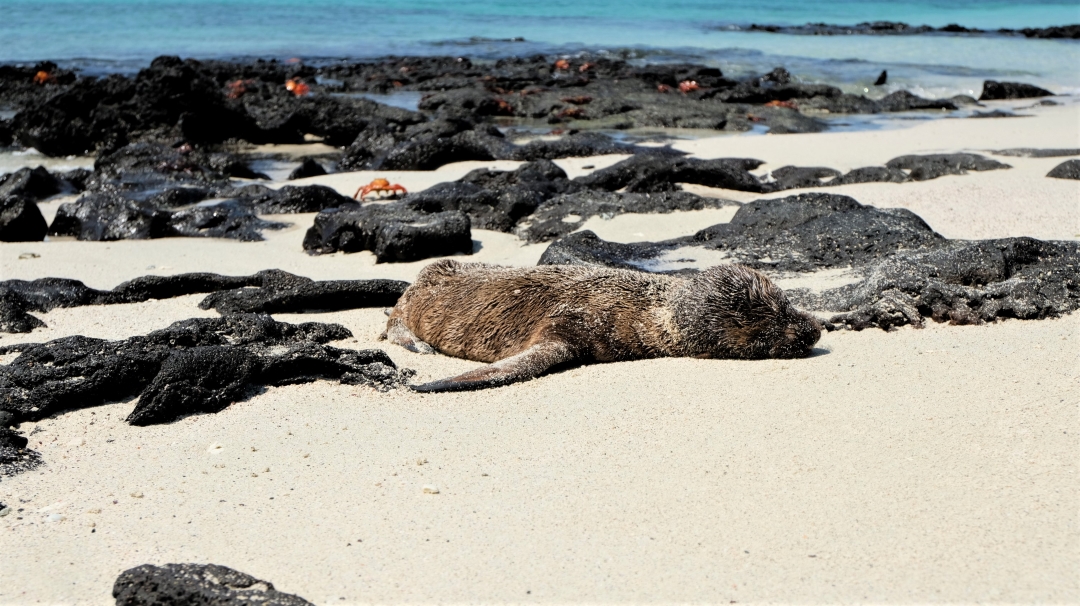
Animals of The Galapagos Islands
The animals of the Galapagos are its star attraction! You’ll see wildlife whichever islands you visit, but if you have a particular favourite, such as the Galapagos penguin or hammerhead shark, you should try to plan your trip around the spots where you’re most likely to see them.
Many of the animals of the Galapagos are endemic, meaning they can be found nowhere else on earth. Due to the low number of predators in the Galapagos, many of the animals are not afraid of humans. Some, like the superstar Galapagos sea lions, are playful and curious animals which are likely to come over and take a good look at you! Visiting the Galapagos is the closest you’re likely to come to seeing the natural world as it was before humans messed everything up.
I’ve included a table of interesting animals below. I’ve underlined the ones that we saw during our seven-day Galapagos trip, which we did in February 2020. I’ve included the locations and islands where you can see each animal too.
| Animal | Location | Island | Time of Year |
Endemic? |
| Blue-footed booby | Punta Vicente Roca, etc. | Seen all over | Year-round (mating June to August) | No |
| Common dolphin | Open waters | Seen all over, especially off Isabela | June to October | No |
| Darwin’s finches | Puerto Ayora, etc. | Seen all over | Year-round | Yes |
| Flightless cormorant | Punta Vicente Roca, etc. | Seen all over | Year-round (eggs May to October) | Yes |
| Frigate bird | Seen all over | Seen all over | Year-round (mating March to April) | No |
| Galapagos hawk | Punta Espinoza, etc. | Isla Isabela, etc. | Year-round | Yes |
| Galapagos fur sea lion | Punta Espinoza, etc. | Isla Isabela, etc. | Year-round | Yes |
| Galapagos land iguana | Urbina Bay, etc. | Isla Isabela, etc. | Year-round | Yes |
| Galapagos penguin | Tagus Cove, Urbina Bay, etc. | Isla Isabela, Isla Santiago | Year-round | Yes |
| Galapagos sea lion | Seen all over | Seen all over | Year-round | Yes |
| Galapagos shark | Kicker Rock, etc. | San Cristobal, etc. | Year-round | Yes |
| Giant manta ray | Open waters | Seen all over, especially off Isabela | Year-round, December to May | No |
| Giant tortoise | Urbina Bay, etc. | Isla Isabela, etc. | Year-round (hatching December to March) | Yes |
| Golden cownose ray | Punta Vicente Roca, etc. | Seen all over | Year-round, December to May | No |
| Hammerhead shark | Kicker Rock, etc. | San Cristobal, etc. | Year-round, January and June | No |
| Humpback whale | Open waters | Seen all over, especially off Isabela | June to October | No |
| Lava heron | Urbina Bay, etc. | Isla Isabela, etc. | Year-round, (mating September to March) | Yes |
| Lava lizard | Urbina Bay, etc. | Isla Isabela, etc. | Year-round | Yes |
| Magnificent frigatebird | Kicker Rock, etc. | San Cristobal, etc. | Year-round (mating March to April) | Yes |
| Marine iguana | Seen all over | Seen all over | Year-round (nesting December to March) | Yes |
| Orca (killer whale) | Open waters | Seen all over, especially off Isabela | June to October | No |
| Pacific green turtle | Punta Vicente Roca, etc. | Seen all over | Year-round (nesting January) | No |
| Whale shark | Open water | Wolf and Darwin, etc. | June to December | No |
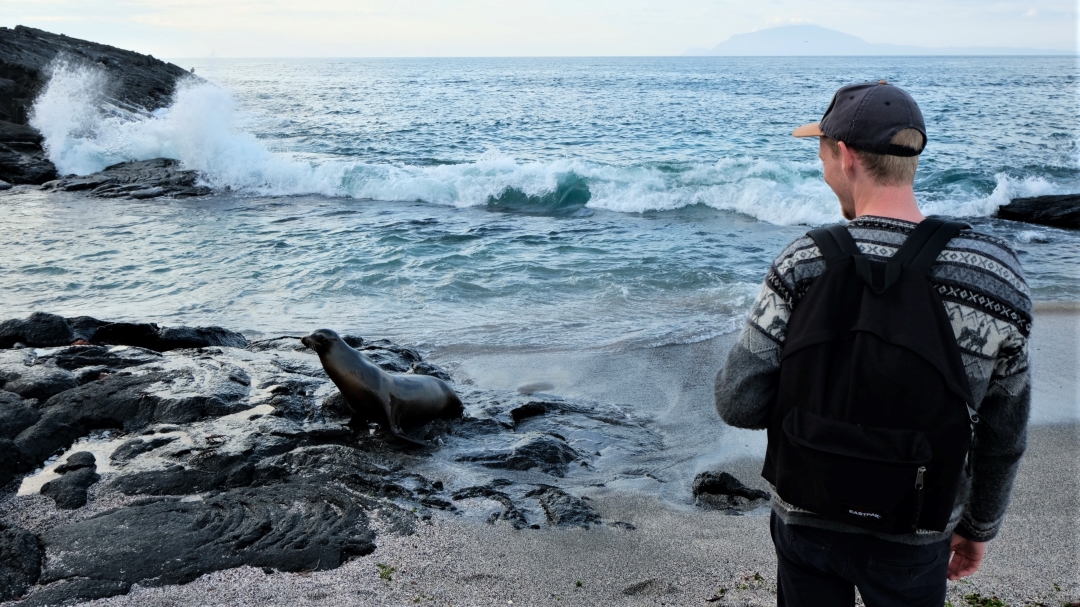
When Is The Best Time To Visit The Galapagos Islands?
You can see many animals all year round in the Galapagos. However, certain animals, particularly whales and dolphins, are more likely to be seen in a certain season. If you are interested in birds and reptiles, you might also want to time your visit to match nesting times.
There are two distinct seasons in the Galapagos: “summer” (sometimes called rainy season or hot season) which lasts from January until May and “winter” (sometimes called dry season) which lasts from June until November.
We visited in February 2020 and got lucky — we were able to see dolphins even though dolphin season is typically from July to November.
| Month | Temperature | Rainfall (mm) | Notes |
| January | 18 to 28°C | 178 | Turtles nesting |
| February | 19 to 30°C | 146 | Penguins return |
| March | 18 to 30°C | 170 | Penguins common |
| April | 19 to 30°C | 156 | Turtles hatch |
| May | 18 to 28°C | 79 | |
| June | 19 to 27°C | 106 | Whales arrive |
| July | 17 to 25°C | 115 | Dolphins arrive |
| August | 16 to 24°C | 80 | Sea lions born |
| September | 15 to 24°C | 86 | Whales & dolphins leave |
| October | 15 to 24°C | 67 | |
| November | 16 to 25°C | 72 | |
| December | 16 to 26°C | 130 | Giant tortoises hatch |
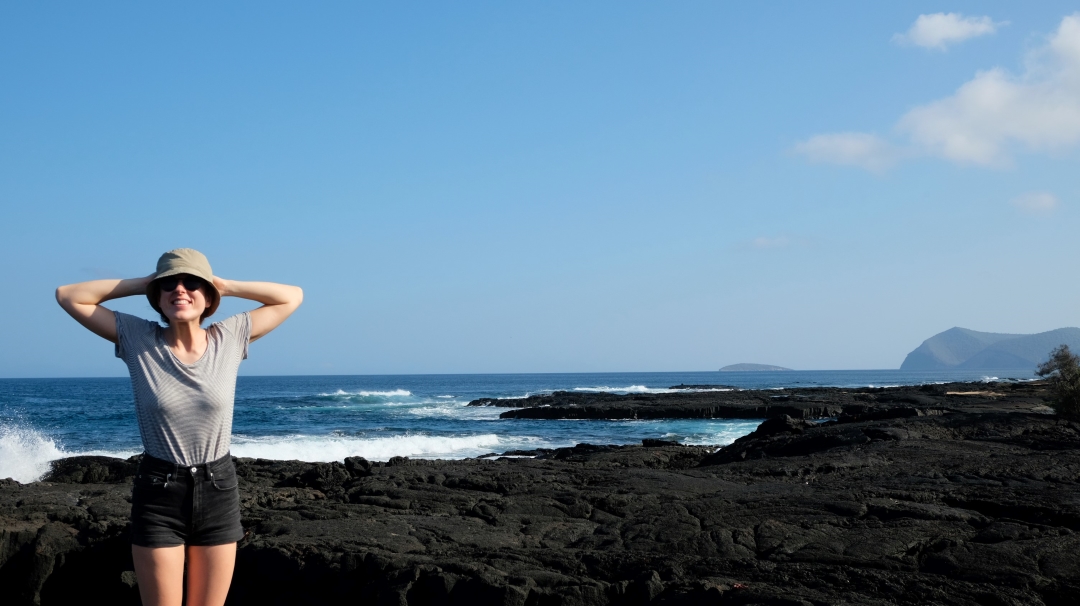
Planning a Galapagos Island Cruise
1. Decide which animals you’d like to see and which islands you’d like to visit
You’re coming to the Galapagos to see wildlife, so make sure the Galapagos island cruise that you pick will stop at the places where you’re most likely to see your favourite animals! Use the animals table at the start of this blog to help you plan.
2. Decide what time of year to visit the Galapagos
The best time of year for you will depend on your availability and the animals that you’d like to see! Use the table at the start of this blog to get an idea of when is the best time for your visit. If you want to see dolphins or whales, then your best bet is to come from June to September.
3. Decide what kind of boat you’d like to stay on
There are probably two factors to consider when picking a boat. 1) The number of passengers. If you pick a very big boat, you’re going to be sharing the snorkelling spots with a huge number of other people. This might reduce your chances of seeing animals. 2) Budget. Different boats have different prices. We identified a couple of boats in our budget then used TripAdvisor reviews to rule boats in or out. We decided against the budget option Golondrina, for example, because reviews said that the engine is loud throughout the night and we’re light sleepers. This travel agency site gives a good overview of your potential boats for the Galapagos island cruise. There are also luxury cruise options, such as those offered by Rainforest Cruises and Touring Galapagos.
4. Decide on your itinerary
Your itinerary is the route your Galapagos island cruise will take. Galapagosislands.com has the itineraries for each of the boats that they work with listed on their website. In my opinion, it’s best to choose an itinerary that spends as little time as possible around the islands of Santa Cruz and San Cristobal. These are both wonderful islands, but you can easily visit them on your own by adding a few days to the end of your trip. Instead, look for an itinerary that takes you to places that are difficult or impossible to visit by ferry.
You should also think about the length of time you’d like to spend on your Galapagos island cruise. Do you suffer from seasickness? A shorter cruise, either four or five days, could be your best bet. Do you want to get to a distant uninhabited island, such as Wolf? You’ll need to pick a longer cruise. We chose a five-day cruise that started on Santa Cruz and visited Isla Isabela, Fernandina and Santiago. We then travelled to San Cristobal by ferry to spend two additional days diving. For me, this was the perfect length of time that I needed to see everything.
5. Contact a travel agency to book your trip or contact the boat owners directly
It’s finally time to book your Galapagos island trip! I’d recommend double-checking everything — reviews, itinerary, your calendar — as this is a trip you’re only likely to do once and it’s important to get it right. We paid through a bank transfer and the process went smoothly. Your travel agent may book your flights for you, or you may decide to book your flights separately.
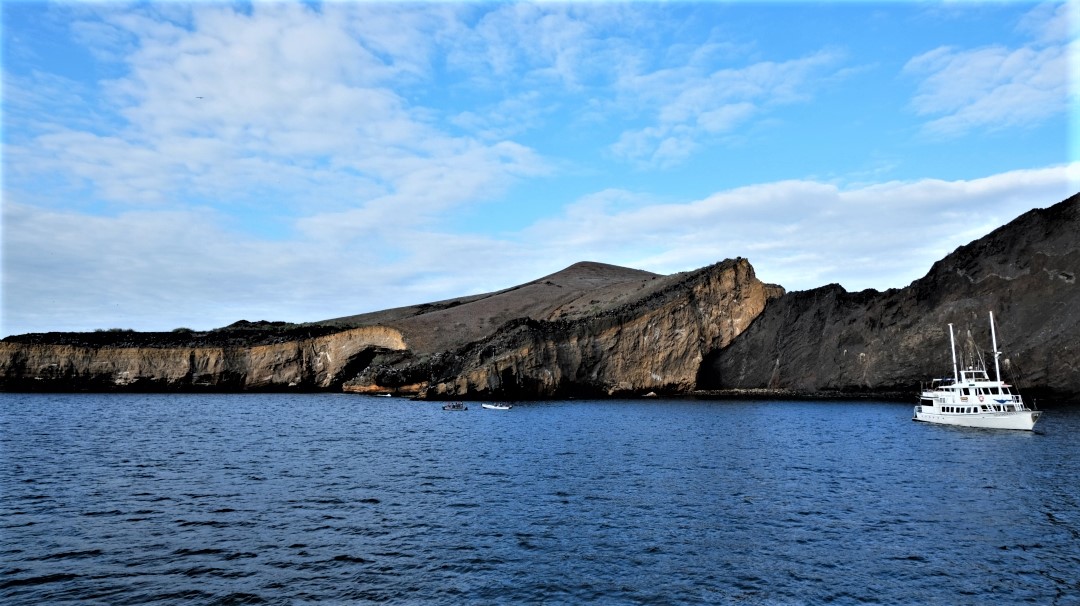
Is The Galapagos Expensive?
Visiting the Galapagos is eye-wateringly expensive. It’s the most money we’ve spent on any travel destination in such a short trip. In total, an eight-day Galapagos trip with a five-day cruise and two days of diving cost us $3,150 per person. Here’s the cost breakdown:
- Flight from Quito to Santa Cruz ($175)
- Galapagos entry fee ($100)
- Galapagos tourist card ($20)
- Galapagos five-day cruise, plus bank transfer fee ($2,215)
- Wetsuit and snorkelling hire for four days ($25)
- Food and drink ($76)
- Accommodation ($50)
- Ferry ticket from Santa Cruz to San Cristobal ($30)
- Diving for two days ($300)
- Flight from San Cristobal to Quito ($158)
Itinerary For Visiting The Galapagos Without a Cruise
It’s possible to visit the Galapagos without paying for a cruise. This will reduce the costs massively and, done right, you don’t have to miss out on some of the best diving or snorkelling sites, such as Kicker Rock. If you don’t book a cruise, try to book your snorkelling and diving in advance online, as spaces do fill up fast. If I were to visit the Galapagos without taking a cruise, here’s the itinerary I’d follow:
- Day 1: Fly to San Cristobal (Galapagos) from Guayaquil or Quito. If you arrive early, hire snorkelling equipment and snorkel at Tijeretas Muelle. It’s a 20-minute walk from Puerto Baquerizo Moreno.
- Day 2: Snorkelling day trip to Kicker Rock. Enjoy a sundowner at MUYU.
- Day 3: Take a ferry from San Cristobal to Isla Isabella, via Santa Cruz.
- Day 4: Snorkelling day trip from Isla Isabella to Los Tuneles.
- Day 5: Take a morning ferry from Isla Isabella to Santa Cruz. In the afternoon, visit the Charles Darwin Research Centre. Enjoy an iced coffee at 1835 Coffee Lab after the visit.
- Day 6: Snorkelling day trip from Santa Cruz to Bartolome, North Seymour or Santa Fe.
- Day 7: Fly from Santa Cruz to Quito or Guayaquil.
If you have time in the morning before your flight, hire snorkelling equipment and visit Las Grietas or Tortuga Bay, both of which are walk-able from town.
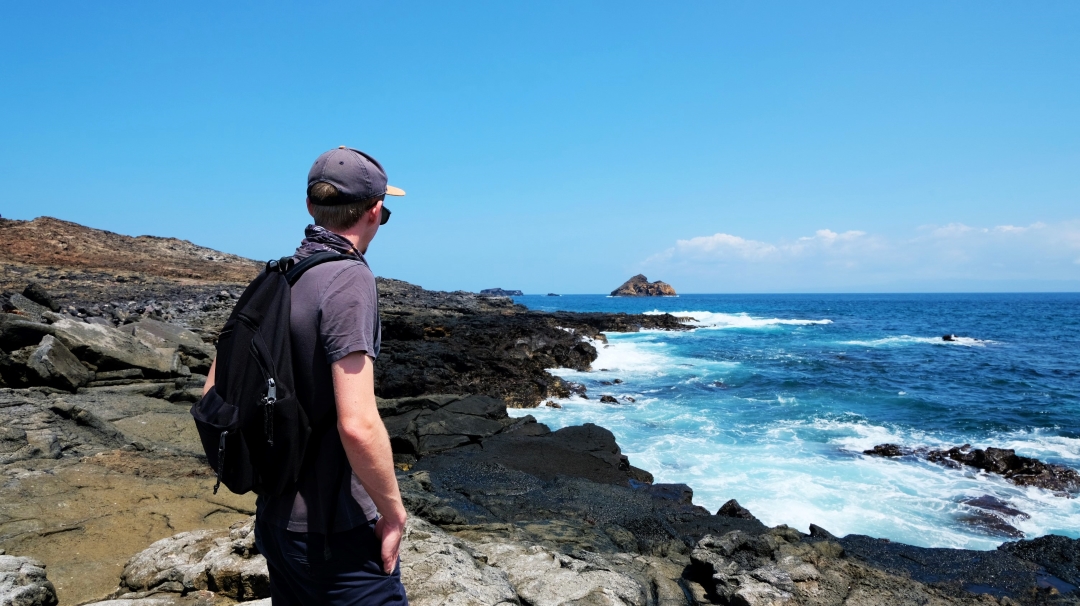
How Much Does It Cost To Visit The Galapagos Without a Cruise?
If you were to use the itinerary above, which would allow you to see Galapagos penguins, hammerhead sharks and many other iconic Galapagos animals, all without taking a cruise, then you could spend as little as $1,312 per person.
- Flight from Quito to San Cristobal ($158)
- Galapagos entry fee ($100)
- Galapagos tourist card ($20)
- Wetsuit and snorkelling hire for two days ($30)
- Food and drink ($165)
- Accommodation ($184)
- Ferry ticket from Santa Cruz to San Cristobal ($90)
- Snorkelling day trips, x3 ($390)
- Flight from Santa Cruz to Quito ($175)
You could reduce this cost a little by spending less on food and drink by making your own meals. For a budget restaurant in San Cristobal, I recommend Lucky’s. You can get a hearty vegetarian plate for $4.50. For a taste of luxury while on a budget, I recommend MUYU. MUYU is a hotel right on the seafront, complete with palm trees and sea lions lazing on the white sand. MUYU isn’t normally cheap, but you can get a delicious vegetarian wrap and a great cup of coffee for $7.50 from their breakfast menu.
Snorkelling, Diving and Animal Spotting in The Galapagos
Before you set off, I recommend that you read up on the best snorkelling and diving spots in the Galapagos. You can see different animals at different spots and different times of the year and that can help you plan your trip.
For example, Charlie wanted to swim with Galapagos penguins and I wanted to swim with Galapagos sharks! We worked out that to have the best chance of seeing both animals we’d have to visit at least two islands: Isla Isabela and San Cristobal.
Snorkelling and Things To Do on Santa Cruz, The Galapagos
Santa Cruz is home to the Galapagos’ largest town: Puerto Ayora (22,000 population). The largest airport of the Galapagos, Baltra Airport (also called Seymour Airport), is technically on a separate island, but it’s a short ferry over to Santa Cruz from the airport. While you’re on Santa Cruz, make sure you use the ATMs as cash isn’t always easily accessible on other islands.
Snorkelling on Isla Mosquera
Isla Mosquera is a white speck of sand not far from Santa Cruz. We visited Isla Mosquera as the first stop of our five-day cruise. There’s an adorable sea lion nursery and a colony of small marine iguanas. I also saw an enormous blacktip reef shark while taking a dingy to the shore. The water here was warm and clear.
We booked our five-day Galapagos island cruise on the Fragata directly from the owners of the boat, which seemed to be cheaper than going via a travel agency.
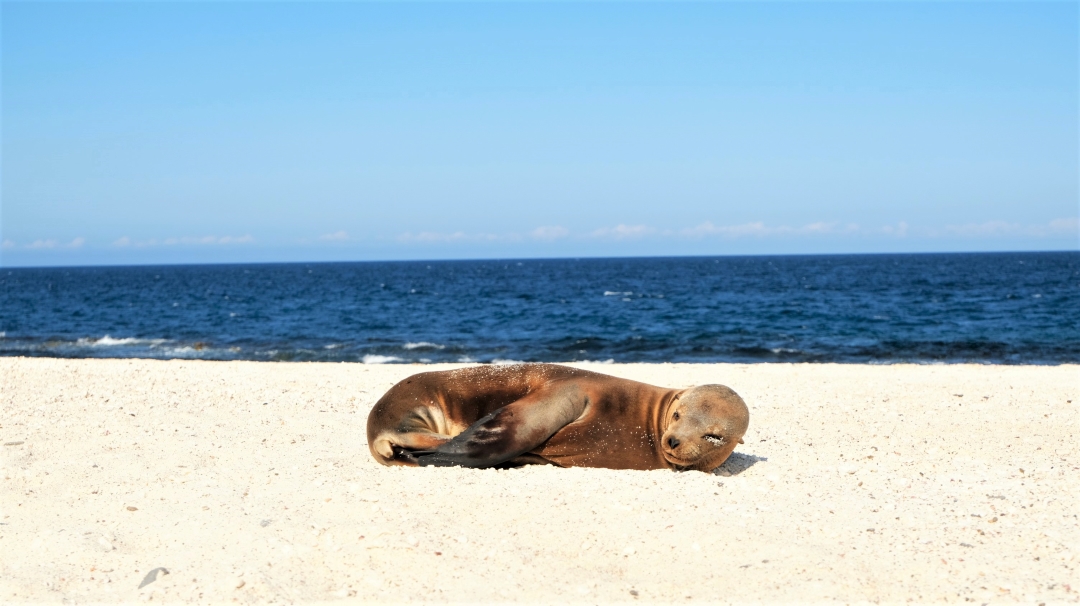
See Giant Tortoises at The Charles Darwin Research Centre
It’s a twenty-minute walk from Puerto Ayora to the Charles Darwin Research Centre. Scientists are working hard to breed giant tortoises and land iguanas here and restore their populations across the Galapagos. You need to enlist a guide to visit the centre and you can also see adorable baby giant tortoises.
Snorkelling and Things To Do On Isla Isabela and Fernandina, The Galapagos
Isla Isabela is the largest island in the Galapagos. It’s mostly uninhabited, though there is a small town (Puerto Villamil) on the southern tip of the island. Ferry services connect Isla Isabela with Santa Cruz and San Cristobal. Fernandina is a small island on the western side of Isabela. The channel between Isabela and Fernandina is a great place to see dolphins and whales.
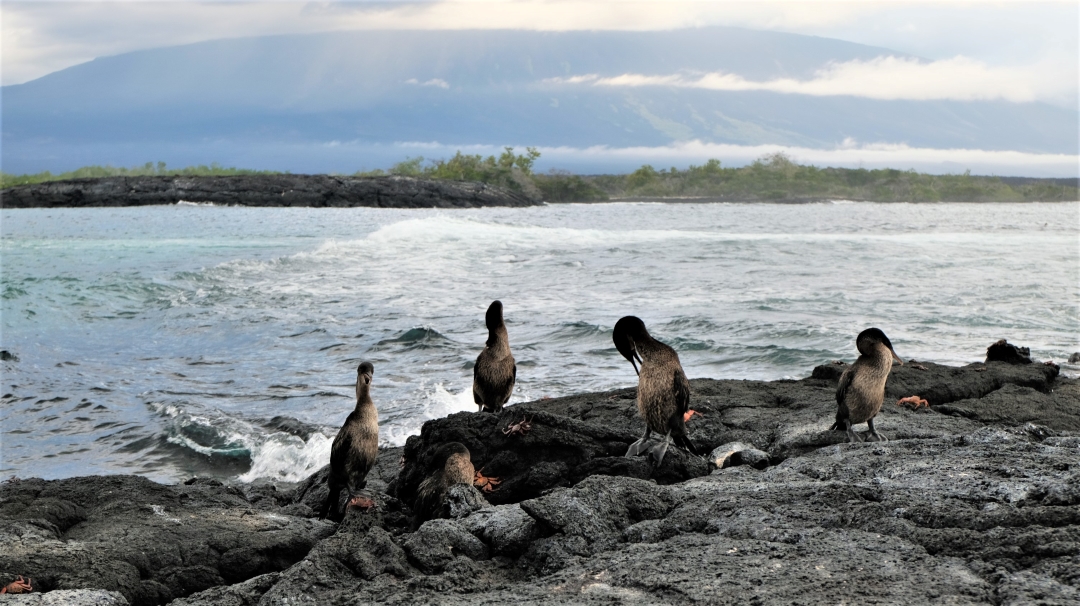
Snorkelling at Punta Vicente Roca, Isla Isabela
Top pick! Punta Vicente Roca was one of the best snorkelling sites we visited in the Galapagos. It’s located right at the top of Isabela. Even before I got off the boat I saw two giant manta rays — one leaping out of the water and landing back in with a belly flop! We also saw nesting blue-footed boobies, Galapagos penguins, flightless cormorants, a shoal of golden cow-nose rays and a heap of beautiful Pacific green turtles. We visited Punta Vicente Roca as part of our five-day Galapagos Island cruise. The water was clear and warm.
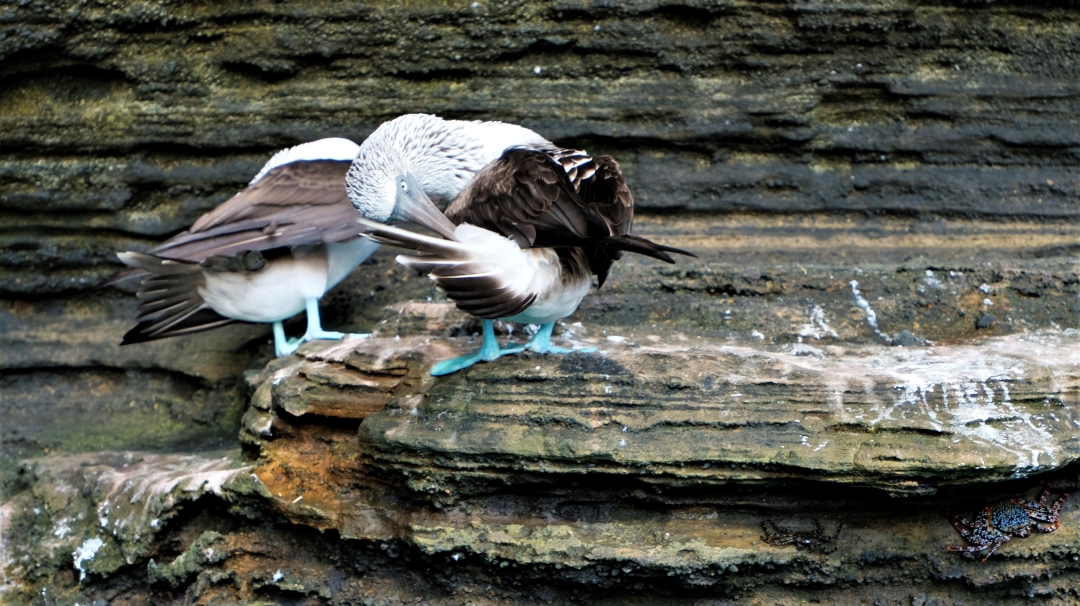

Snorkelling and Animal Spotting at Urbina Bay, Isla Isabela
Top pick! We were very fortunate when we came ashore at Urbina Bay! We saw loads of wild giant tortoises and land iguanas. Giant tortoises are amazing creatures and their sheer size (up to 450kg) is something to see. Urbina Bay in Isla Isabela is one of the best places to see Giant Tortoises in the wild. Thanks to the efforts of scientists at the Chares Darwin Research Centre, the population is recovering. We visited Urbina Bay as part of our five-day Galapagos Island cruise.
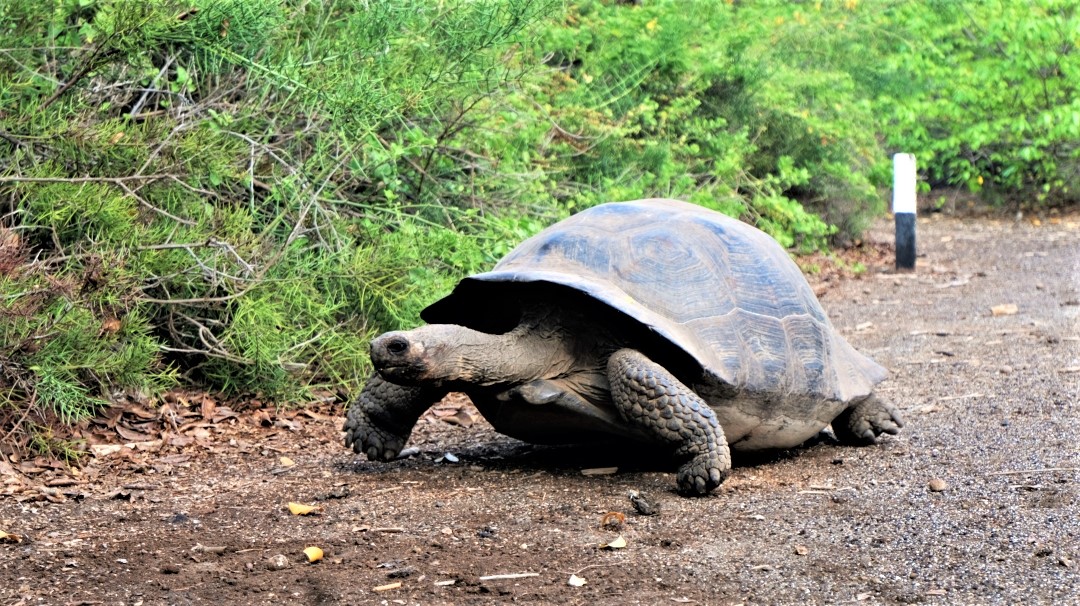
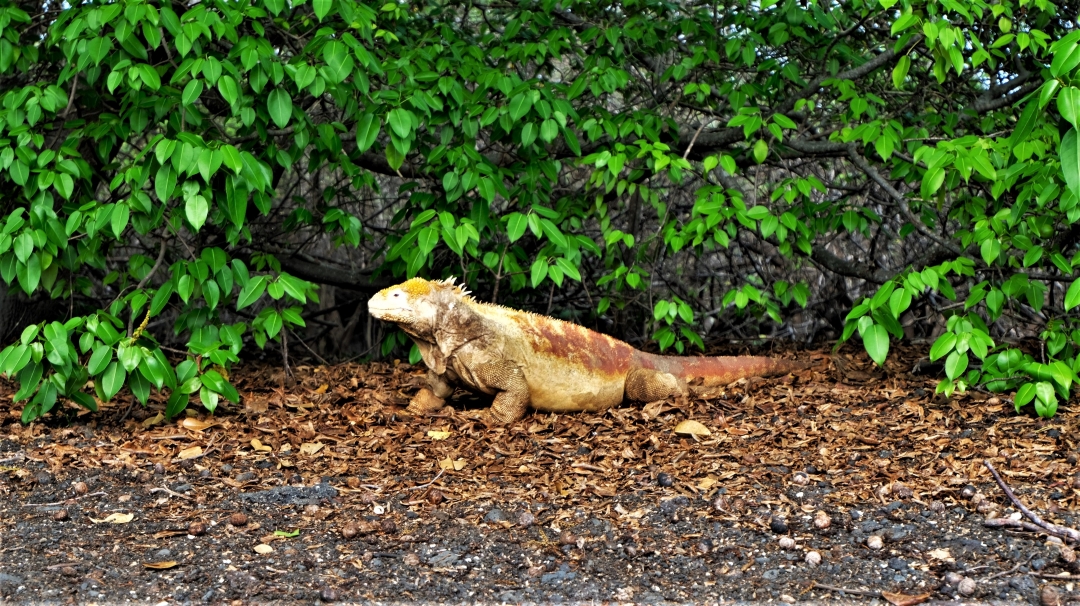
Snorkelling at Tagus Cove, Isla Isabela
Tagus Cove, on Isla Isabela, is one of the best places to swim with Galapagos penguins. The cove isn’t pretty, and passing ships have made things worse by adding graffiti which can still be seen to this day. But penguins, turtles and even small sharks love to cold and murky water here. Catching a glimpse of a penguin is difficult as they swim so fast, but we saw a number of them while snorkelling. Playful sealions also swam with us for a time, which was an unforgettable experience.
Snorkelling and Animal Spotting at Punta Espinosa, Isla Fernandina
Top pick! Punta Espinosa is hands down the best place to see marine iguanas, which amass in great heaps around the beaches. Strangely, marine iguanas spend a lot of time spitting. This is because they take in a lot of seawater while eating algae and they need to spit to remove saltwater from their system.
We also saw some Galapagos hawks here, which are the islands’ top “land” predator, as well as tonnes of sea lions and a few penguins. We visited Punta Espinosa as part of our five-day Galapagos Island cruise. We snorkelled here too, but we didn’t see much aside from a handful of turtles in the water. The water was cold and cloudy.
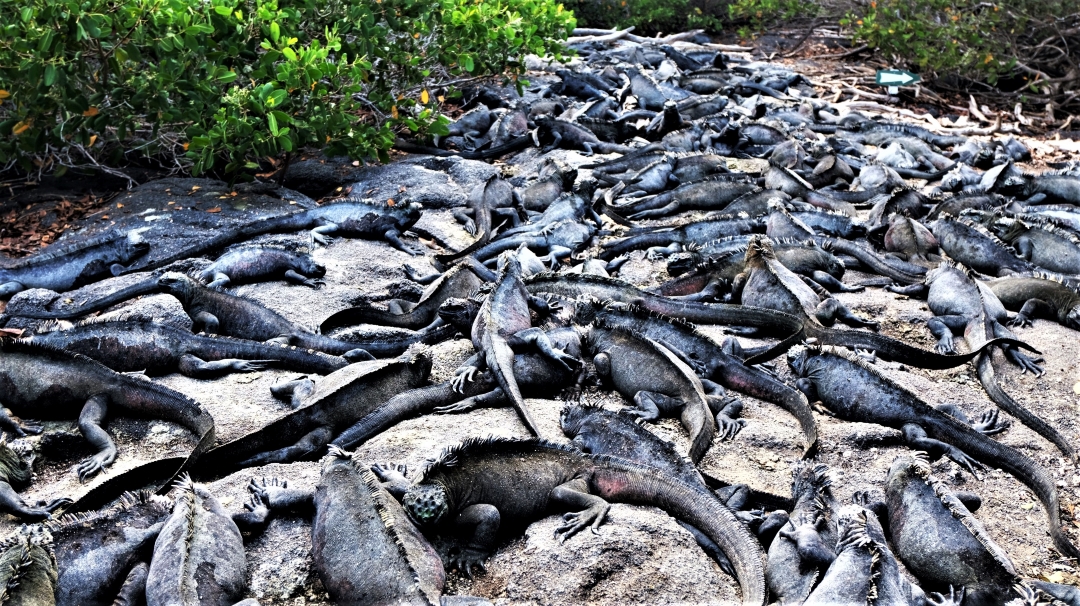
Snorkelling and Things To Do on Isla Santiago, The Galapagos
Isla Santiago is a largeish uninhabited island between Santa Cruz and Isla Isabela. Like the other islands of the Galapagos, it’s volcanic. That means the landscape is made up of black lava fields as well as sandy beaches of different colours. The vegetation is mostly cactuses and small shrubs rather than palm trees!
Snorkelling At Puerto Egas On Isla Santiago, The Galapagos
Puerto Egas is a great place to snorkel with small, white-tip reef sharks. We also saw a lava heron here as well as the fur sea lion. Unlike the Galapagos sea lion, which can be found everywhere, the fur sea lion is hard to spot in the wild. We visited Puerto Egas on our way back to Santa Cruz as part of our five-day cruise. This is a great snorkelling spot with warm waters and clear visibility.
Snorkelling at Sombrero Chino On Isla Santiago, The Galapagos
Top pick! Another great place to snorkel with small sharks in the Galapagos is Sombrero Chino. Might be a good option if you’d like to swim with sharks but feel a little nervous! This snorkelling spot felt very tropical with warm, crystal clear waters and an abundance of marine life, including rays and lobsters. We visited Sombrero Chino as part of our five-day cruise.
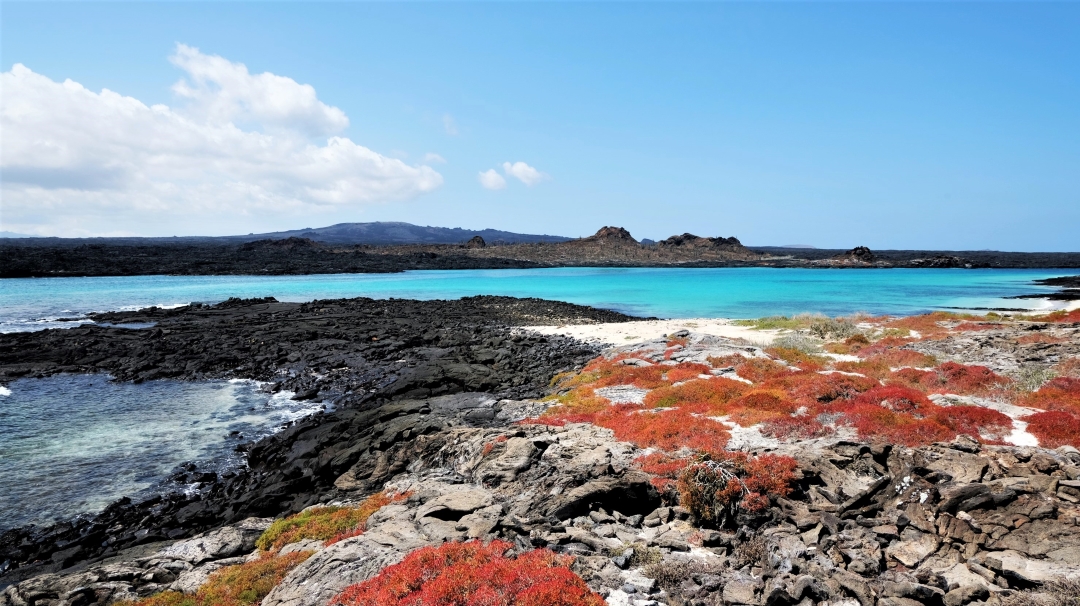
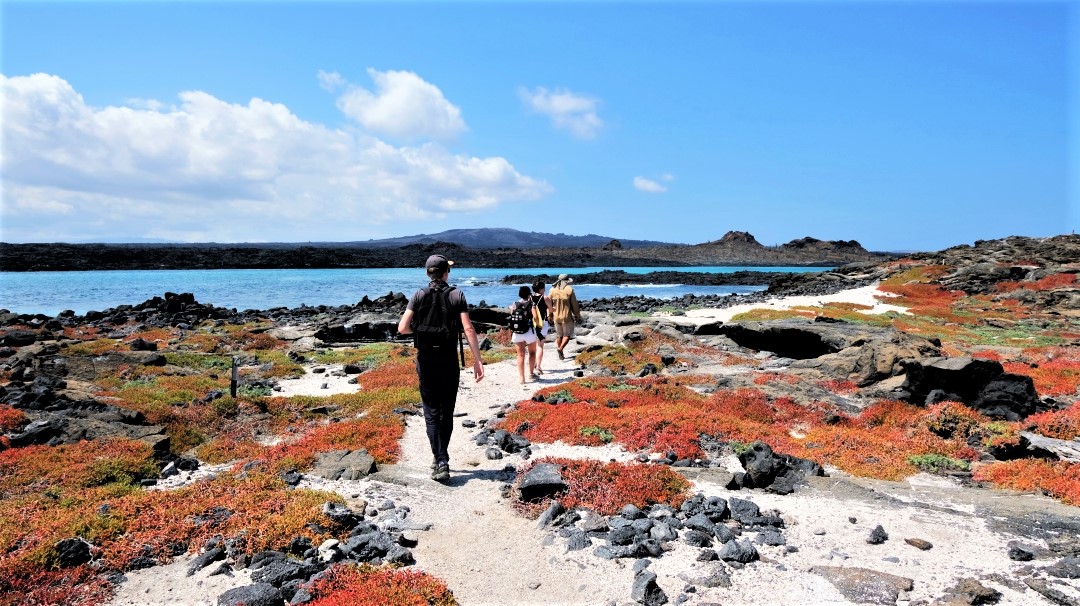
Snorkelling and Diving on San Cristobal, The Galapagos
San Cristobal is the easternmost inhabited island of the Galapagos. It has a small town, Puerto Baquerizo Moreno, where you can arrange day trips to the famous Kicker Rock, which is a 40-minute or so boat ride away. You can also withdraw money here, though we’ve heard the ATM can sometimes run out of cash. You can catch a ferry from here to Santa Cruz or Isla Isabela.
Diving At Caragua Wreck, San Cristobal
This shipwreck, over 90 years old, can be found in the bay of Puerto Baquerizo Moreno. We saw playful Sea Lions, Green Turtles, several rays and even an octopus. There’s a semi-enclosed tunnel that you can swim through. Parts of the ship are clearly visible. The water was cold but clear.
I booked my wreck dive for $140 from Alpha Scuba. This included two tanks of air and a refresher dive before the wreck dive. I booked in town, but I was quoted similar prices online and wish I’d booked in advance. I’ve also heard good things about Wreck Bay, which is another diving company.
Diving at Kicker Rock (Channel), San Cristobal
(Top pick!) The channel between Kicker Rock is an excellent place to dive with sharks, including hammerhead sharks. While diving the channel, a big hammerhead shark passed within a few metres of our group. We saw plenty of other sharks (black-tip, white-tip and Galapagos sharks) in the same dive. Other fish were beautiful and abundant. Note that Kicker Rock is known as Leon Dormido in Spanish.
Diving at Kicker Rock (Tail), San Cristobal
(Top pick!) When diving at the tail end of Kicker Rock, we passed through a shoal of fish so large that they blocked out the sun and it was like diving at night. We saw many hammerhead sharks and other large sharks as well as yellowfin tuna and barracuda at this dive site. Above the water, it’s possible to see Magnificent Frigatebirds nesting on the tail of Kicker Rock.
The water was warm enough and the visibility was good – but it can drop as low as 5 metres if you’re unlucky. If you feel the cold easily, ask for a 7 mm wetsuit. There’s a gentle surge in the channel and a strong current at the tail. Our divemaster did a safety check and assessed our skills before the dive at Puerto Grande.
The cost is $160 for two dives at Kicker Rock, with lunch included. We set off at 9 and we’re back in port by 14:45. Seasickness tablets are essential. You can pay $110 to snorkel at Kicker Rock. Snorkelers and divers share a boat. The snorkelers on our boat saw several sharks but no hammerheads. It’s possible to see hammerhead sharks while snorkelling at Kicker Rock.
Galapagos Islands Airports
All flights to the Galapagos connect via Guayaquil (GYE), which is a city on the coast of Ecuador. Even if you book a flight from Quito (UIO), you might find that you have a technical stopover at Guayaquil for around forty minutes.
There are three airports in the Galapagos:
- Seymour Airport (GPS) on Baltra Island (closest to Santa Cruz).
- San Cristobal Airport (SCY) on San Cristobal Island.
- Emetebe on Isabela Island.
Confusingly, Seymour Airport is sometimes known as Baltra airport and sometimes known as Santa Cruz airport. Emetebe is little more than a landing strip. You can only fly from Guayaquil to Seymour Airport or San Cristobal Airport.
You’ll have to buy a tourist card ($20) when boarding your plane at Quito or Guayaquil. When you arrive in the Galapagos, you’ll have to buy a Galapagos entry ticket ($100).
The Galapagos is very strict about protecting the national park from introduced animals and vegetables. It’s best to play it safe and not bring any fresh food or plants of any kind into the island. You’re also not supposed to bring camping equipment, including hiking boots, into the island.
If you do fly to the Galapagos, do consider paying to carbon offset your flights. Frequent air travel is very carbon-intensive. You can read our guide to offsetting your carbon emissions to help you calculate the cost.
Galapagos Packing List
This travel packing checklist includes everything you need to pack. Don’t forget your passport and important documents too! I haven’t included it as an essential, but consider bringing your own snorkelling mask. It’ll save you a few pennies on renting one and should be much more comfortable.
Luggage and Travel Bags
Travel Documents
Travel Tech
Travel Essentials
|
Clothing
Travel Toiletries & Medical Kit
|



